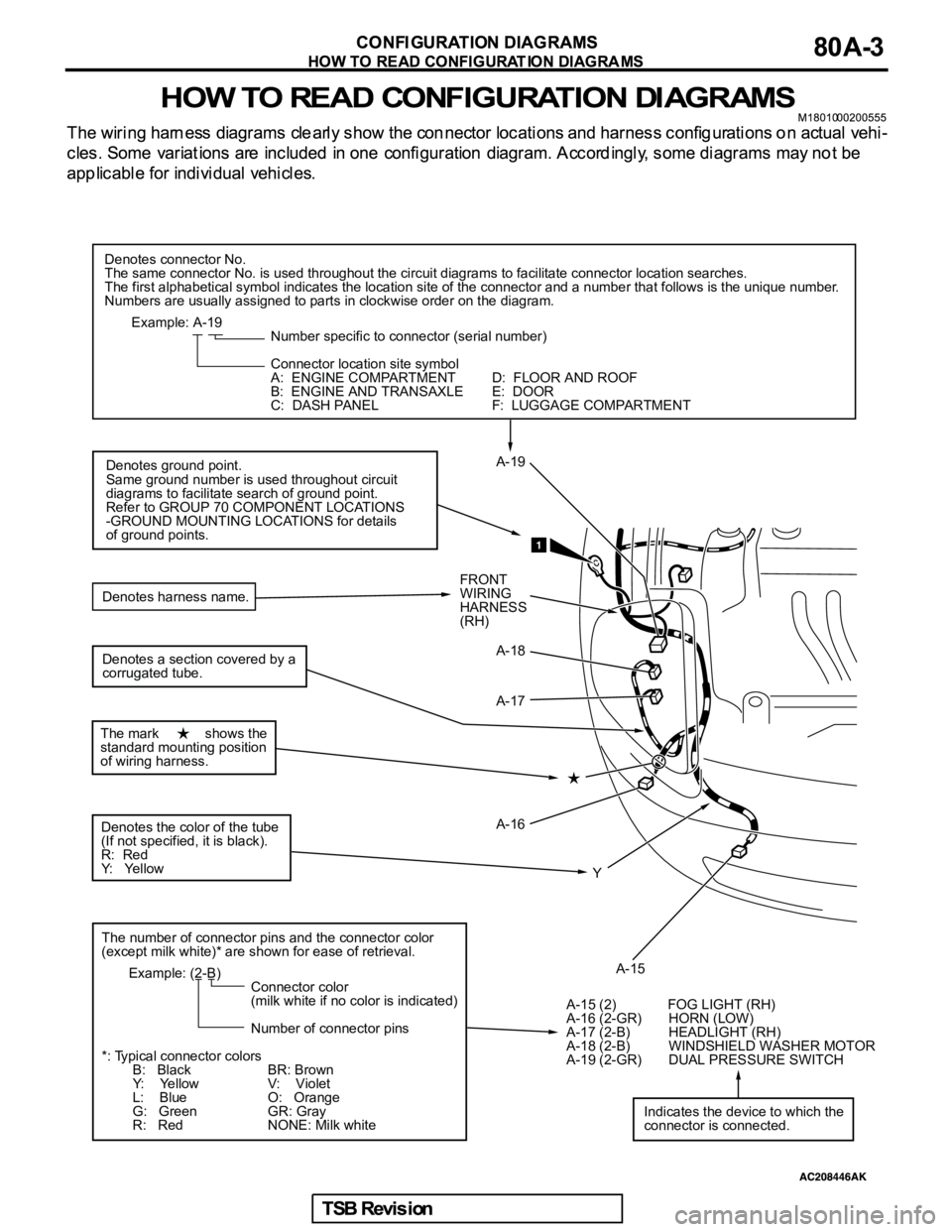Page 597 of 1000

Denotes connector No.
The same connector No. is used throughout the circuit diagrams to facilitate connector location searches.
The first alphabetical symbol indicates the location site of the connector and a number that follows is the unique number.
Numbers are usually assigned to parts in clockwise order on the diagram.
Example: A-19
Number specific to connector (serial number)
Connector location site symbol
A: ENGINE COMPARTMENT D: FLOOR AND ROOF
B: ENGINE AND TRANSAXLE E: DOOR
C: DASH PANEL F: LUGGAGE COMPARTMENT
Denotes ground point.
Same ground number is used throughout circuit
diagrams to facilitate search of ground point.
Refer to GROUP 70 COMPONENT LOCATIONS
-GROUND MOUNTING LOCATIONS for details
of ground points.
Denotes the color of the tube
(If not specified, it is black).
R: Red
Y: Yellow
The number of connector pins and the connector color
(except milk white)* are shown for ease of retrieval.
Example: (2-B)
Connector color
(milk white if no color is indicated)
Number of connector pins
*: Typical connector colors
B: Black BR: Brown
Y: Yellow V: Violet
L: Blue O: Orange
G: Green GR: Gray
R: Red NONE: Milk white
A-15 (2) FOG LIGHT (RH)
A-16 (2-GR) HORN (LOW)
A-17 (2-B) HEADLIGHT (RH)
A-18 (2-B) WINDSHIELD WASHER MOTOR
A-19 (2-GR) DUAL PRESSURE SWITCH
Indicates the device to which the
connector is connected.
The mark shows the
standard mounting position
of wiring harness.
A-17
A-16
A-15 A-18 A-19
Y
Denotes a section covered by a
corrugated tube.
FRONT
WIRING
HARNESS
(RH) Denotes harness name.
Page 640 of 1000

Indicates power source.
Indicates that terminal is conne-
cted via a plate in the relay box.
Each circuit diagram consists of
block(s). The blocks are divided
by page number.
Indicates splice point numbers.
These numbers are identical to
those described in "Splice Loca-
tions."
Indicates the circuit name to be
connected. The arrow indicates
the current flow direction.
Indicates the power supply in
the control unit. If no voltage is
displayed, this indicates battery
positive voltage.
An "X" at the end of a connector
number indicates that the conn-
ector is connected to a central-
ized junction that is shown in the
section "Centralized Junction."
Indicates the connector symbol.
Connectors in the circuit diagram
are indicated in numerical order.
Indicates connector number.
The same number is used in the
wiring harness diagram.
Connector and connector numbers
are shown at the lower part of the
page.
Connector numbers not enclosed
by frame indicate the device incor-
porated into wiring harness.
Indicates the circuit name
to be connected. The arrow
indicates the current flow
direction.
Indicates that the diagram contin-
ues at which belongs to the
block in the same circuit.
One-directional arrow indicate
that current flows upwards.Indicates shield wire.Indicates the operating conditions
of the engine coolant switch, etc.
Page 641 of 1000

Indicates representative vehicle
body ground point. (Same
number as that of ground point in
GROUNDING LOCATION).
Indicates harness junction where
wire diameter or color changes.
In case two or more connectors
are connected to the same de-
vice, markings indicating
the same connector is
connected by a broken line.
Indicates terminal number.
Indicates intersections at
which the lead wires are
not connected.
Indicates intersections at
which the lead wires are
connected.
Indicates input/output
to/from control unit
(current flow direction).
InputOutputInput/
output
Indicates that the diagram comes
from which belongs to the
block in the same circuit.
Indicates a wiring connector which is inside
the equipment and which is not shown in
the wiring harness configuration diagram.
Example C-15-2
Indicates a connector
which is inside the
equipment, numbered
in order starting from 1.
Indicates the connector number shown in
the wiring harness configuration diagram.
Bi-directional arrow indicates
that current flows in both direc-
tions due to control by an ECU.
Indicates that the terminal is a
spare one if the device (sensor
in this case) is not provided.